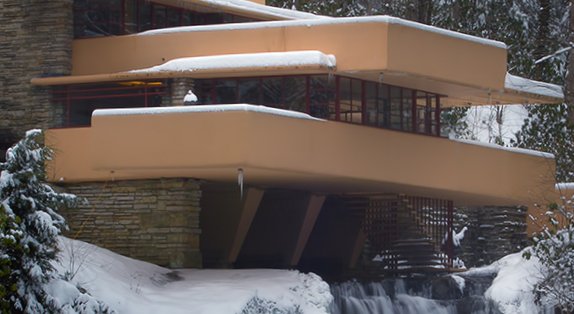There are a couple of structural aspects to Fallingwater that aren't immediately obvious. The cantilevers are dramatic; there's no question about that, but much of the drama is actually sleight of hand.
In hindsight, it could have used more structure than illusion, but I still think some of the ways Frank Lloyd Wright Wright concealed the structure are pretty clever.
First, below the lowest terrace there are four piers, which carry much of the weight of the first floor. Even these corbel out from the hillside, so that they reach out over the stream rather than stand vertically in it.
 The
terraces look as if they're open boxes made of concrete; you don't see
any beams under them. But actually, the beams are within them. The
concrete structure is like the egg-crate or double-T structure of a
modern parking garage, except that it's upside down, so that the terraces
have flat undersides. Wright then laid redwood boards to span the space
between the beams, and the flagstone floor is on top of that.
The
terraces look as if they're open boxes made of concrete; you don't see
any beams under them. But actually, the beams are within them. The
concrete structure is like the egg-crate or double-T structure of a
modern parking garage, except that it's upside down, so that the terraces
have flat undersides. Wright then laid redwood boards to span the space
between the beams, and the flagstone floor is on top of that.
We're so used to thinking of post -> beam -> floor when we look at a building that it's natural to assume that if we don't see any beams from the underside, there aren't any beams. It's a natural assumption that there are these concrete trays, and the next day some masons came in and spread some mortar on the bottom of them and laid the flagstones, but that's just an illusion.
Another illusion that Wright used was to make some of the window mullions structural. All of the outer walls in the living room are windows; there are no corner posts. It's breathtaking, and you hardly notice that a couple of the window mullions are structural steel, because there's no difference in material, it's always glass, metal, glass, metal, glass, metal, glass.
Those mullions transfer the load to the (hidden, inverted) beams on the lower terrace, which transfer the load to the piers down at the stream level.
So the upper terrace just seems to fly out from nowhere; it's supported by a glass wall that in itself is part of a terrace that has most of its structure hidden in the first place. For a last bit of sleight of hand, Wright threw out a couple more horizontal planes that don't support anything at all; they just extend the horizontal lines at little structural cost while adding to the impression of a building that just flings itself out over the waterfall with no visible means of support.
From the beginning people said that Fallingwater would collapse; that it was not structurally sound. Wright meant for it to look like an impossible structure in the first place. If it was as flimsy and airy as it looks, it would have fallen down before it was finished. I'm impressed that the structure is so cleverly disguised, and if they have to spend a few million dollars after sixty years to drill in some steel that should have been there in the first place, so be it.
In spite of the fact that this remedial work is necessary, the ways that Frank Lloyd Wright Wright concealed the structure on this house are remarkably clever. Half engineering, and half sleight of hand. And the house still looks like it's flying, after 65 years.